2022.07.02.52
Files > Volume 7 > Vol 7 No 2 2022
1,2,3 Biology Department, College of Science, University of Baghdad
*Corresponding author' email is: [email protected],
Available from: http://dx.doi.org/10.21931/RB/2022.07.02.52
ABSTRACT
This study included an analysis of three stations (Al Dora, Al Za'franiya, and Arab Ejbur) chosen to study the Physiochemical and microorganism (Fungi and Bacteria) loud of the Tigris River in the southern section of Baghdad city. The result of this research shows that the highest temperature recorded in summer in Al Za'franiya was 37Co, while the lowest temperature recorded in winter in Al Dora was 9Co. and the value of pH recorded the highest in summer it was 7.9 in Arab Ejbur, and the lowest value was in winter 7.1 in Al Dora regions, While Total Organic Carbon (TOC) shows the highest values found in the summer was 6.7 Mg L-1in Al Za'franiya Samples, and the lowest values were 2.0 Mg L-1in Arab Ejbur during the winter. The more frequently isolated fungi were Aspergillus niger, and the lowest frequently was Chrysosporium was observed during the survey period. At the same time, Bacteriological analysis of water resources showed that Escherichia coli and Pseudomonas aeruginosa were more frequently isolated bacteria and the lowest frequently bacteria were Klebsiella ornithinolytica and Proteus mirabilis.
Keywords. Fungi, Bacteria, Temperature, TOC, pH, Tigris River.
INTRODUCTION
Over the last few decades, understanding the mechanisms that determine microbial biodiversity in aquatic environments has been a significant focus of freshwater ecology research. Migratory microbial communities, which are found in freshwater environments, are made up of a diverse group of bacteria, fungi, and archaea responsible for various processes that are critical to ecosystem functioning. These processes include carbon cycling and biological nitrogen fixation as well as denitrification and methane production, sulfate reduction, and the transformation of metals and various molecules that are found in the environment 1. In the absence of treatment, the release of untreated effluents can limit the microbiological diversity of natural environments, which may have a detrimental impact on the functioning and health of aquatic ecosystems. According to the findings of many research, both changes in local circumstances and the presence or absence of biotic interactions may impact the formation of microbial communities in fluvial networks. To measure the health of an ecosystem, it has been proposed that microbial diversity and community composition be used as sensitive indicators of ecosystem health since they may be impacted by water pollutants 2. The contamination of natural water bodies by industrial, agricultural, and urban wastewater can affect the composition, structure, and microbial activity of the water body on a local and global scale, resulting in a decline in aquatic life and soil fertility; as a result consequence.
As a consequence of drastic changes in the structure and composition of these communities, unanticipated alterations in nutrient flow may occur 3. The diversity and composition patterns of aquatic fungal communities have been influenced by pollution. The amount of nutrients dissolved in water, for example, has a significant influence on the diversity and composition patterns of aquatic fungal communities 4. Despite this, most environmental microbiology sequencing investigations have concentrated on prokaryotic species, with microbial eukaryotic communities being generally ignored in the process5. Apart from their contribution to aquatic environments, bacterial populations play an essential role in transforming and demineralizing nutrients 6. To keep the energy flow going. A significant role in the biodegradation of allochthonous compounds, such as pollution originating from human activities, is played by surface-associated bacterial communities, which are especially prevalent in rivers 7. A river's importance to civilization is shown by the fact that it provides water for consumption, agriculture, and the removal of human waste. However, in contrast to our understanding of marine and freshwater lake microbiology, the ecological influence of planktonic and attached bacteria within river ecosystems is still understudied and underappreciated8. As the primary supply of irrigation for Iraqi land, the Tigris River has significant significance for Iraqi environmental researchers due to the negative impact of pollutants arising from treated and untreated home waste and agricultural pollutants 9. However, according to a previous study conducted on the Tigris River in Baghdad city, the quality of water becomes worse when it reaches the city's southern cross because the study area is densely populated along its banks, as well as having some industrial activities present, as well as having some wastewater fallings that are distributed on both sides of the river and discharge the waste into a stream of Tigris River10. As a result, this research aims to survey the microorganisms (fungi and bacteria) in the south Tigris River in Baghdad city and examine their appearances and characteristics.
MATERIALS AND METHODS
Study area
This study was included an analysis of three stations (Al Dora, Al Za'franiya, and Arab Ejbur) that were chosen to study the Physiochemical and microorganism (Fungi and Bacteria) loud of the Tigris river in the southern section of Baghdad city figure (1), for a period of twelve months from November 2017 to October 2018. Obtaining representative samples has proven to be problematic due to the heavily populated nature of the study location along the river's banks, as well as the presence of diverse industrial activities, making it necessary to get these samples, in addition to several fallings the wastewater, which are distributed on both sides of the river and throw the waste to the Stream of Tigris River.
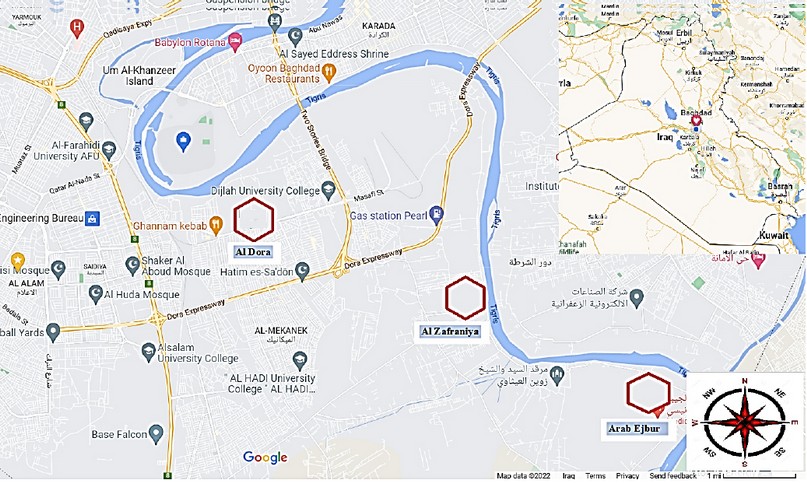
Figure 1. Shows the selected study areas within the city of Baghdad
Collection of water samples
The water samples taken from south of Tigris River from three regions(Al Dora, Al Za'franiya, and Arab Ejbur) were collected in the morning every month using sterile polyethylene containers to 10.
Isolation and Identification of Fungi:
Isolation of fungi was carried out by standard isolation techniques 11. Some drops of water samples were separated using a spreader on Potato Dextrose agar (PDA) and Sabrouid Dextrose agar (SDA) and then incubated at room temperature for one week in a dark place. After one week, the fungi appeared on the surface of the agar. Fungi colonies were identified according to the shape of the colony and microscopically identified according to their spores and fungal filaments according to the fungi manual 12 with support of various standard references and monographs 13.
The Percentage of Occurrence and Frequency
The percentage of occurrence and frequency is defined as follows in equation 14:
Isolation and Identification of Bacteria
Bacterial surveys of water samples, including total viable bacterial count, were carried out in accordance with the general standard methodology for the study of water and wastewater, as previously described 15. A conventional coliform fermentation procedure, comprising presumptive, confirmed, and finished tests, was used to detect total coliform, fecal E. coli, and Pseudomonas aeruginosa 16. A variety of dilutions of water samples from various sources were distributed over a variety of agars, including Eosin-Methylene Blue Agar (EMB), Nutrient agar, Thiosulfate citrate bile sucrose Agar (TCBS) medium, Macconkey agar, and Blood Agar, to identify additional harmful enteric bacteria at 37°C, the plates were incubated overnight, and the cultures were inspected for different colonies the next day after incubation. After being streaked on nutrient agar slant and cultured for 24 hours at 30°C, these colonies were retained as stock cultures. Bacteriological techniques that are currently in use 17 and API20E were employed to determine the identity of each isolate.
RESULTS
Temperature
The obtained results showed that the highest temperature was 37Co in summer in Al Za'franiya, while the lowest temperature was 9 Co in Al Dora in winter, as in Table (1).
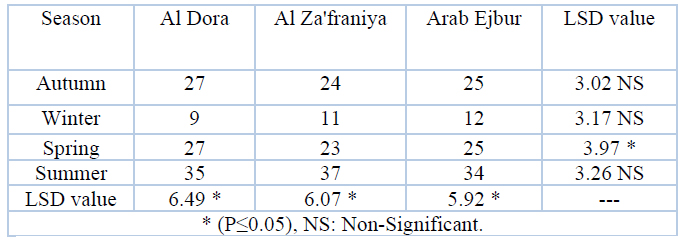
Table 1. Effect of Station and Season on Temperature
Although there were statistically significant differences between the stations, no statistically significant differences existed between the seasons except the spring season, which had significant differences that reached 3.97 at the level of (P≤0.05) and no statistically significant differences between the seasons.
Hydrogen Ion (pH)
The maximum (7.9) and minimum (7.1) values of pH were recorded in the Arab Ejbur and Al Dora region during Summer and Winter, respectively these values agree with Iraqi standards for maintenance of rivers No. 25 of 1967, which was 6.5-8.518 as shown in Table (2).
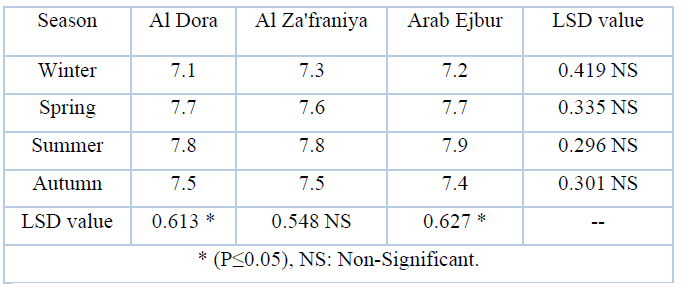
Table 2. Effect of Station and Month on pH
According to the statistical study, there were no statistically significant differences across the seasons, but that there were statistically significant differences between the two stations of Al-Dora and Arab Al-Jabour, with differences reaching up to 0.613 and 0.627 respectively at the level of (P≤0.05).
Total Organic Carbon (TOC)
The highest values for drinking water found in summer were 6.7 Mg L-1in Al Za'franiya
Samples and the lowest values were with 2.0 Mg L-1for Arab Ejbur in winter. Table (3).
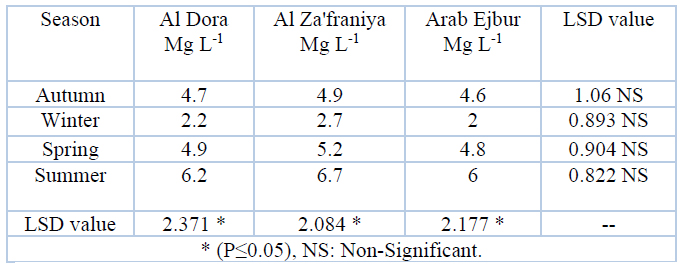
Table 3. Effect of Station and Month in (TOC).
Following the statistical analysis, it was discovered that there were no statistically significant variations between the seasons, and that there were no statistically significant differences between the stations at the level of (P≤0.05).
Isolation and Identification of microorganisms
The obtained results revealed that 18 fungal species were identified in the (Al Dora, Al Za'franiya, and Arab Ejbur) stations and their appearances threw the study season as explained in Table (4). While the number of bacteria species was 14 in the study station and study season Table (5).
Fungus isolation and Identification
The fungus species were isolated throughout four seasons. Aspergillus niger was the fungus that was isolated the most often. Rhizopus sp., Fusarium sp., Trichophyton megnini, and Mycelia sterilia are among the pathogens that have been identified, Table (4).
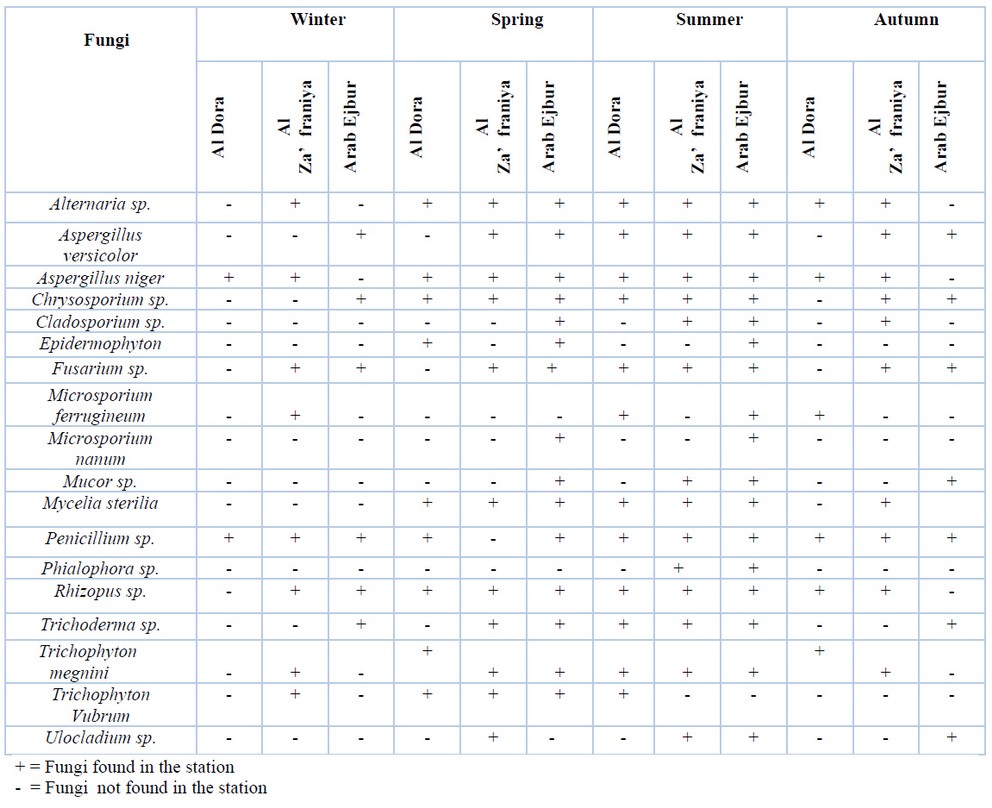
Table 4. Prevalence of fungal species isolated during the study period from (Al Dora, Al Za'franiya, and Arab Ejbur) stations
18 fungal genera are isolated; Aspergillus niger is the most common genus and is always represented during the study period, followed by the Rhizopus genus. The fungal genera Aspergillus, Rhizopus, Fusarium, Trichophyton, Mycelia, Mucor. Penicillium, Microsporum, Trichoderma, Alternaria, Ulocladium, Phialophora, Epidermophyton and Chrysosporium were observed during the survey period.
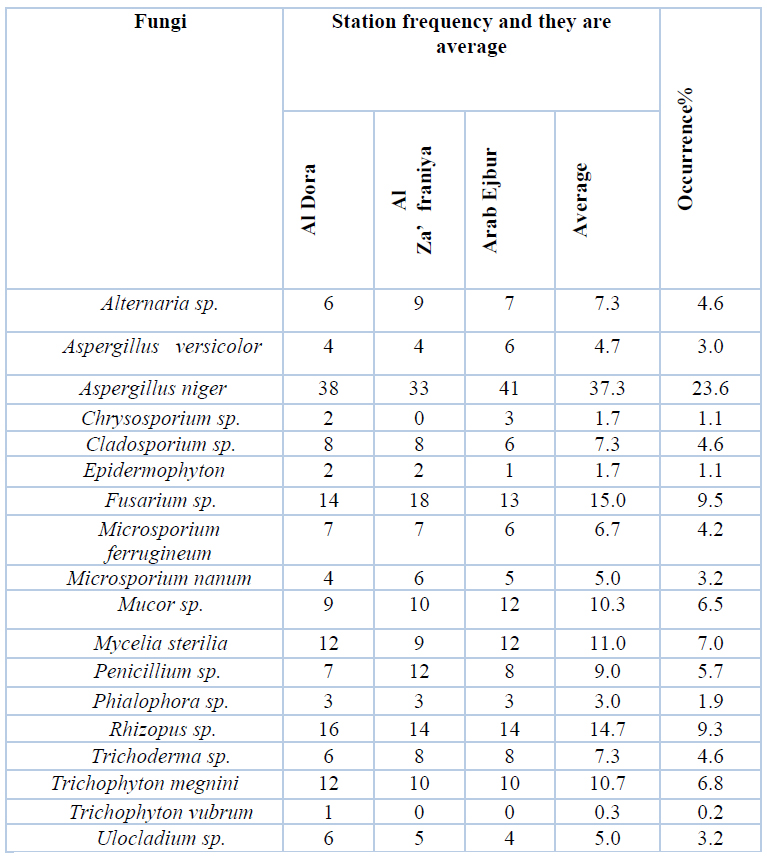
Table 5. Occurrences and frequency of fungal genera isolated from (Al Dora, Al Za'franiya, and Arab Ejbur) stations
Isolation and Identification of bacteria:
The total viable bacterial counts, total coliforms, total E. coli, and total Pseudomonas aeruginosa were found to be the most prevalent bacteria in water resources, according to a bacterial investigation, Table (6).
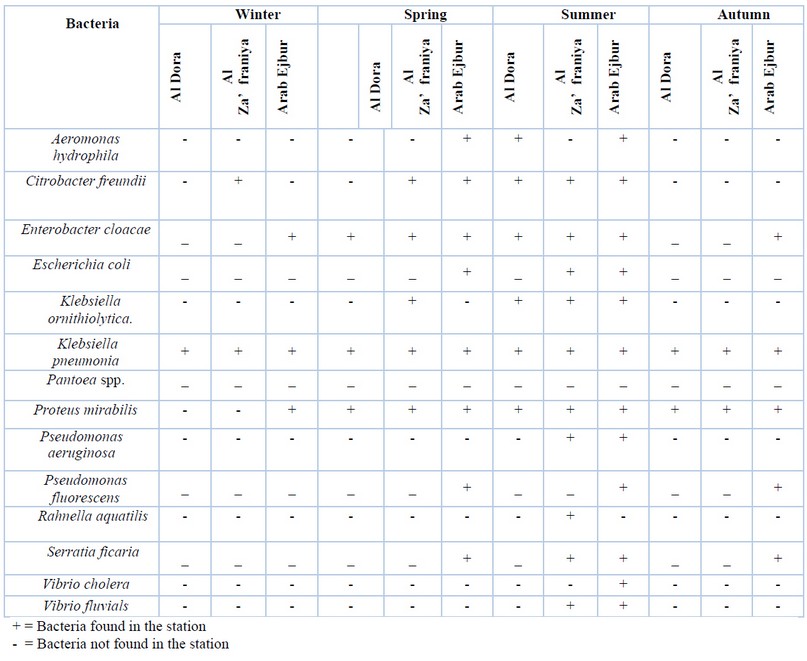
Table 6. Prevalence of bacteria species isolated during the study period from (Al Dora, Al Za'franiya, and Arab Ejbur) stations
According to the data in the paper, at least 14 species of bacteria belonging to the family Enterobacteriaceae are present and several additional species belonging to the family Pseudomonadaceae Table (7). The bacteria E. coli and Pseudomonas aeruginosa were the most often seen.
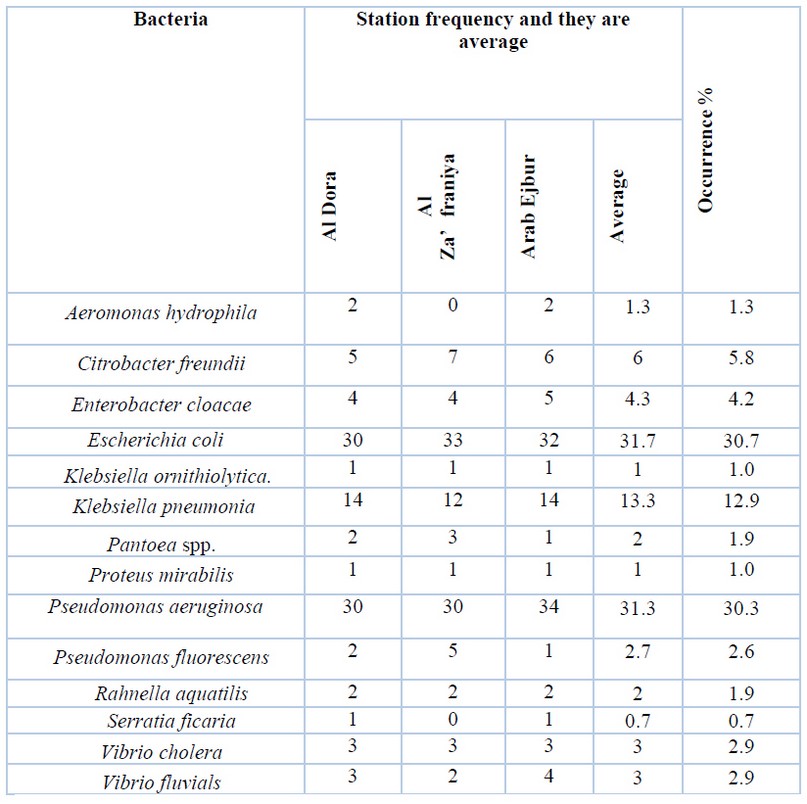
Table 7. Occurrence and frequency of bacterial isolated from (Al Dora, Al Za'franiya, and Arab Ejbur) stations
DISCUSSION
The main reason for the lower degree measured during the winter and higher degree in the summer months is linked directly with air temperature 19. The relatively low pH value obtained in the river during winter may be due to the high levels of free CO2 that is dissolved in water by diffusion from the atmosphere and may be due to the dilution effect 20, while in the summer, CO2 levels are decreased by moving to the atmosphere or consumed via the photosynthesis process of algae or water plants and so, the pH value is raised 21. The research findings indicate that the most considerable fungus abundance was found in a river with a high concentration of organic matter, while the highest microorganism taxonomic biodiversity was found in waters with a high concentration of organic matter. The majority of potentially harmful fungus is found in the water of polluted rivers. Furthermore, elements impacting the structure of microbes include the pH, temperature, and total organic carbon (TOC) of the water 20.
CONCLUSIONS
These microbial counts were far higher than the maximum limits permitted by international standards, particularly at the Al Za'franiya station. According to the water quality in (Al Dora, Al Za'franiya, and Arab Ejbur), a significant quantity of bacteria was found in the water in the southern Tigris River basin. For their part, the physical-chemical parameters were within acceptable ranges of values. This may be due to the contamination of raw water by urban garbage and other sources.
Conflict of interest
No conflict of interest
Acknowledgement
We would like to express our gratitude to the Iraqi Ministry of Higher Education as well as the University of Kerbala for providing us with the facilities necessary to conduct this research. The writers contributed their own funds to this project.
Funds: Self
REFERENCES
1. Chodak M, Gołębiewski M, Morawska-Płoskonka J, Kuduk K, Niklińska M. Diversity of microorganisms from forest soils differently polluted with heavy metals. Applied Soil Ecology. 2013 Feb 1; 64:7-14.
2. Huang JH. Impact of microorganisms on arsenic biogeochemistry: a review. Water, Air, & Soil Pollution. 2014 Feb;225(2):1-25.
3. Bucci JP, Szempruch AJ, Caldwell JM, Ellis JC, Levine JF. Seasonal changes in microbial community structure in freshwater stream sediment in a North Carolina river basin. Diversity. 2014 Mar;6(1):18-32.
4. Dong H, Jiang H, Yu B, Liu X, Zhang C, Chan MA. Impacts of environmental change and human activity on microbial ecosystems on the Tibetan Plateau, NW China. Gsa Today. 2010 Jun;20(6):4-10.
5. Pandey PK, Kass PH, Soupir ML, Biswas S, Singh VP. Contamination of water resources by pathogenic bacteria. Amb Express. 2014 Dec;4(1):1-6.
6. Siegel DA, Buesseler KO, Behrenfeld MJ, Benitez-Nelson CR, Boss E, Brzezinski MA, Burd A, Carlson CA, D'Asaro EA, Doney SC, Perry MJ. Prediction of the export and fate of global ocean net primary production: The EXPORTS science plan. Frontiers in Marine Science. 2016 Mar 8; 3:22.
7. Abia A, Alisoltani A, Keshri J, Ubomba-Jaswa E. Metagenomic analysis of the bacterial communities and their functional profiles in water and sediments of the Apies River, South Africa, as a function of land use. Science of the Total Environment .2017. (1):326-334
8. Ann V, Freixa A, Butturini A, Romaní AM. Interplay between sediment properties and stream flow conditions influences surface sediment organic matter and microbial biomass in a Mediterranean river. Hydrobiologia. 2019 Feb;828(1):199-212.
9. Aghazadeh N, Chitsazan M, Golestan Y. Hydrochemistry and quality assessment of groundwater in the Ardabil area, Iran. Applied Water Science. 2017 Nov;7(7):3599-616.
10. Al-Fatlawy, Y.F.K.Study of the quality of drinking water for some water project in Baghdad .Ph.D. Thesis College of the Science University of Baghdad, Iraq. (In Arabic).2007.
11. Reuter S, Ellington MJ, Cartwright EJ, Köser CU, Török ME, Gouliouris T, et al. Rapid bacterial whole-genome sequencing to enhance diagnostic and public health microbiology. JAMA Intern Med 2013; 173:1397-404.
12. Khulbe RD. A Manual of Aquatic Fungi: Chytridiomycetes & Oomycetes. Daya Books; 2001.
13. Barnett HL, Hunter BB. Illustrated genera of imperfect fungi. Illustrated genera of imperfect fungi. 1972(3rd ed).
14. Nigam N. Occurrence of keratinophilic fungi with special reference to Chrysosporium species in India. Sydowia. 1990; 42:200-8.
15. Caplenas NR, Kanarek MS. Thermotolerant non-fecal source Klebsiella pneumoniae: validity of the fecal coliform test in recreational waters. American Journal of Public Health. 1984 Nov;74(11):1273-5.
16. WHO (World Health Organization). Nitrate and nitrite in drinking-water: Background document for development of WHO Guidelines for Drinking-water Quality. World Health Organization; 2003.
17. WHO (World Health Organization) Guidelines for Drinking-water Quality, Incorporating 1st and 2nd Addenda, Volume 1, Recommendations, 3rd ed.; WHO: Geneva, Switzerland, 2008.
18. APHA, AWWA and WEF, "Standard Methods for The Examination of Water and Wastewater. 22st edition," Washington, DC: American Public Health Association, American Water Works Association, Water Environment Federation, 2012.
19. Kar D, Sur P, Mandai SK, Saha T, Kole RK. Assessment of heavy metal pollution in surface water. International Journal of Environmental Science & Technology. 2008 Dec;5(1):119-24.
20. Baird C. Environmental Chemistry, 557 pp. W.H. Freeman & Co., New York, 2 Ed.2000.
21. Assmy P., Smetacek V. Algal Blooms. Encyclopedia of Microbiology (Third Edition), 27-41 .2009.
Received: 14 February 2022 / Accepted: 12 April 2022 / Published:15 May 2022
Citation. Khalef Al Fatlawy Y F, Abdalqader Mahdii B, Kadhim F. Survey the Microbial Load in the Tigris River in South of Baghdad City and Some of the Physiochemical Parameters. Revis Bionatura 2022;7(2) 52. http://dx.doi.org/10.21931/RB/2022.07.02.52
